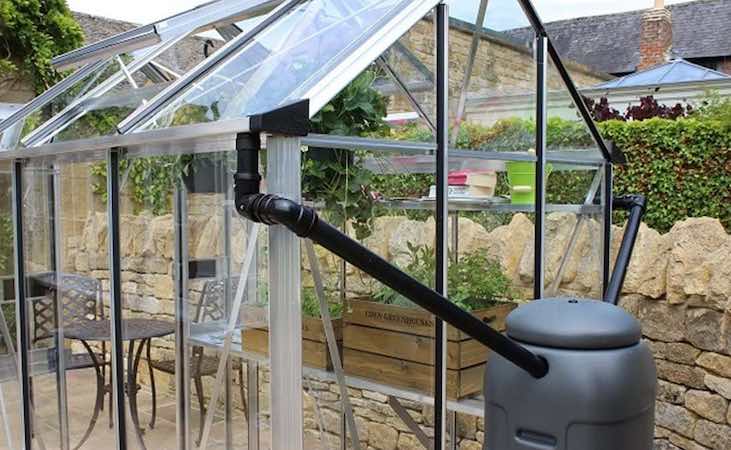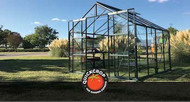Greenhouse Maintenance

A greenhouse is very effective at what it does, but to keep it working to the best of its abilities you should keep on top of any maintenance issues that may arise. Keep a sharp eye on things like window panes and side vents throughout the year, and do one thorough clear-out and inspection once a year (you can combine this with a deep clean). The best time to do this is probably autumn, but it depends on what you’re growing and when. Early spring will work just as well, especially if you've been overwintering plants; while any time you've got a break inbetween sowing/harvest cycles is a good time for maintenance and examining your growing space.
Ventilation
Ventilation is vitally important in a greenhouse: it stops the structure overheating to the point of harming plants, ensures good air circulation and reduces the chances of disease gaining a foothold. The main points of ventilation on the average greenhouse are the roof vent, side vents and the door. Check that the door is closing tightly and not letting in a draught. Hinged doors tend to be more reliable and have a tighter fit compared to sliding doors, which usually rely on ‘brush’ seals. If any of the side vents are squeaking, apply some oil to ensure that they keep opening and closing smoothly.

Doors
Sliding doors can be handy, not just for accessibility but for an extra ventilation option in summer. However, the sliding action can sometimes become jammed - this can be caused by dirt and debris tracked in as you walk in and out of the greenhouse. The wheels can become worn as well, and may need to be replaced. Vacuum out any debris and then spray along the track with vinegar and water. Get a cloth and try to get right down into the track, lifting any remaining dirt.
Check that doors are closing tightly and that locks are functional. Apply oil to the hinges if necessary. If the lock is stiff or getting stuck, some graphite lubricant can get it working smoothly again.
View The Greenhouse Expert - D.G. Hessayon
Draughts
In some ways the flipside of ventilation, you don’t want to have draughts in your greenhouse as they can play havoc, especially as the weather gets cooler or windier. Inspect the greenhouse frame and panels, looking for any gaps that might be evident. It’s a good idea to do this when there’s a stiff breeze outside as it’ll make the inspection job easier, at least on the side that the wind is blowing towards. Some draught excluders or adhesive strips can be used to plug up small gaps. Check that doors and vents are fitting tightly when they close. Check also that the base is solid and firm: gaps or weaknesses in the structure here can allow an entry-point for pests and cold draughts.

Guttering
If the guttering becomes blocked, water will start to leak over the glazed panes and the framework of the greenhouse. This can cause a build-up of algae or rot on the outer structure, so it’s important to clear any leaves or debris out of the guttering every few months. If the downpipe has a blockage, use a wire coat hanger to try and lift any debris out near the top. Similarly, if the blockage is near the bottom, straighten out a coat hanger and push up the pipe to try and free the obstruction. A wire mesh can be placed at the entrance of the downpipe to filter out any large debris that could cause future blockages. Loose brackets may need to be replaced or tightened if the gutter is visibly sagging.
Panes
Check to see that all panes are firmly fixed in position, and that there are no cracks or damage. Glazing repair tape can be used temporarily but any cracked panels should be replaced as soon as possible. Even if it seems like a small crack, a spell of high winds could blow the panel in or push it out of its frame. With greenhouse panels you can choose between horticultural glass and polycarbonate, as well as toughened, reinforced glass. When the glazing needs to be replaced, you can even opt to switch out glass for polycarbonate: polycarbonate is much more durable and can withstand very harsh weather conditions. It’s not quite as attractive as glass, although it still has impressive light transmission abilities. Replacing glazing is generally an easier task than it might sound: glazing clips and glazing bars allow you to slot the panels into place. Having said that, always be very careful when handling glass.

Wood
Although they’re not as common as aluminium greenhouses, wooden greenhouses remain popular due to their charming aesthetic. They’ll also require a fair bit more upkeep, although just how much can depend on the kind of wood the frame has been crafted from (cedar is more rot-resistant). Watch out for any signs of damp and mould. Doing a good clean once or twice a year and repainting every couple of years will keep the wood in good condition. Linseed oil is a plant-safe wood preservative that can replace natural oils and is suitable for using on all wood types.
Be vigilant when it comes to dry rot: panel edges and parts of the lower frame are particular spots to inspect. Spongy or darkened wood can be early warning signs. Once it sets in it can spread extensively, generating its own moisture. Polyester filler or a wood hardener can be used to repair rot. With the filler you will be able to mold and shape the finished look. If the damage is more extensive it might be better to replace the wood altogether.
